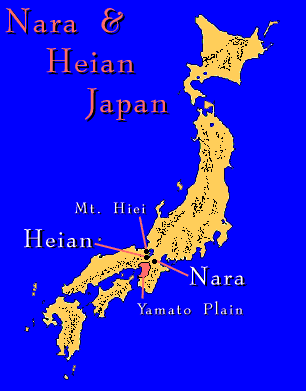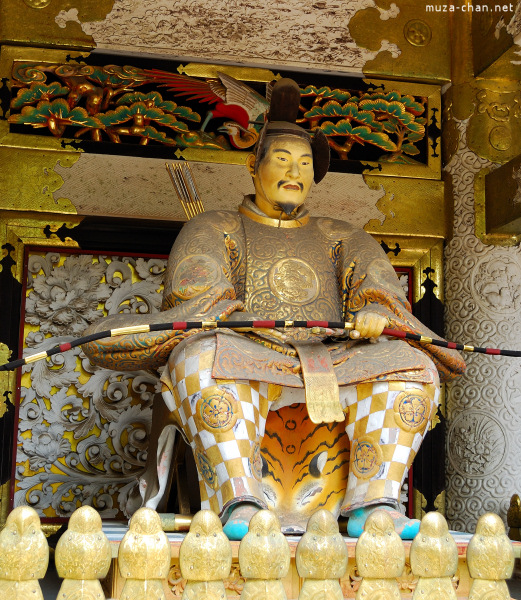In 794 the capital of Japan was officially transferred to Heiankyo (present-day Kyoto), where it remained until 1868. The city’s name means “Capital of Peace and Tranquility,” and the Heian period is usually remembered as having been an age of art, literature, and culture. Nowhere was this more apparent than in the design of the largest pre-Heian capital, a city called Heijō-kyō. Modeled on the Tang capital of Chang’an, Heijō-kyō was laid out in a grid-like pattern, with streets running north-south and east-west. The imperial palace was built in the north so that the Japanese emperor could face south and look out over his people, in keeping with Chinese ideas of geomancy. Because the capital was primarily located in Heijō (modern Nara) between 710 and 784 C.E., these years are referred to as the Nara period.
Religions, Beliefs, Values
During the Nara and Heian periods, Buddhism and Shinto religions continued to blend. In the Heian Period, the blending went so far as to recognize Buddha as coming to the Japanese through Shinto gods. The best example of this is the combining of Shinto with Shingon Buddhism, a particular sect of Buddhism. The sect believed that Shinto gods were the manifestation of Buddha. The Sun Goddess Amaterasu was seen as coming through the Great Sun Buddha.
By the year 1000, Esoteric Buddhism was being eclipsed by the popularity of the worship of Amida Buddha. The concept of Amida's heavenly "Pure Land" greatly influenced the arts, giving rise to elegant architectural forms and paintings and sculpture that reflected the idyllic beauty of Amida's paradise.
The highest rank (senior first) was reserved for the emperor. Members of the highest nobility who served as ministers of state might hold second or third ranks. Younger up-and-coming nobles and some members of the provincial governing class might hold fourth or fifth rank. The lower ranks were generally given to bureaucratic experts, clerks, and skilled technicians. Possessing a rank made one eligible for appointment to office. As there were more ranked candidates than open offices, however, individuals used gifts (i.e., bribes), political connections, or other means to try to win appointments. Securing office was very important to these men, as it furthered their political careers and guaranteed them income. Women received rank but were not eligible for offices such as minister or governor. However, powerful women at court were important political figures and often influenced decisions on who received appointments. Even so powerful a figure as Michinaga, for example, owed much of his success to the support of his elder sister Senshi, who had already married into the imperial family.
Politics
By the end of the ninth century, the most powerful figures at court were members of a noble family known as the Fujiwara. Sometimes compared to the Frankish mayors of the palace in European history, the Fujiwara never replaced the imperial family. Rather, they monopolized key ministerial positions and wielded enough power to control the emperors.
Economy
While on one hand the Heian period was indeed an unusually long period of peace, it can also be argued that the period weakened Japan economically and led to poverty for all but a tiny few of its inhabitants. The control of rice fields provided a key source of income for families such as the Fujiwara and were a fundamental base for their power. The aristocratic beneficiaries of Heian culture, the Yokibito numbered about five thousand in a land of perhaps five million. By the year 1000 the government no longer knew how to issue currency and money was gradually disappearing.
Demography
Year
|
Heian Population
|
622
| |
750
| |
800
|
200,000
|
900
|
200,000
|
925
|
200,000
|
1000
|
175,000
|
1100
|
175,000
|
1150
|
150,000
|
1200
|
100,000
|
1250
|
70,000
|
1300
|
40,000
|
1350
|
150,000
|
1400
|
150,000
|
1450
|
150,000
|
1500
|
40,000
|
1550
|
100,000
|
1575
|
300,000
|
1600
|
300,000
|
The Christian missionaries led by Francis Xavier reported that the number of houses in Kyoto, Yamaguchi or Hakata was more than 90,000, more than 10,000 or 10,000, respectively, in the late 16th century according to History of Japan written by Luis Frois.
Intellectual Developments & Technology
By the end of the period, about 40 percent of the boys and 10 percent of the girls were provided education outside the home. These figures probably meant Japan's education opportunities and literacy rate were ahead of most countries in the world, with the exception of two or three nations in the West. Kukai, established a monastery on Mt. Koya, which became the educational center for Shingon Buddhism. Kukai's central role in the history of Japanese education is evidenced by his having invented Kana, the Japanese alphabet, and by his effort to establish a school that addressed the needs of commoners, a group not enrolled in the Daigakuryo or the kokugaku. His private academy, the Shugei Shuchiin, did not exclude the lower classes and promoted the personal, moral, spiritual, and intellectual development of its students.
By the end of the period, about 40 percent of the boys and 10 percent of the girls were provided education outside the home. These figures probably meant Japan's education opportunities and literacy rate were ahead of most countries in the world, with the exception of two or three nations in the West. Kukai, established a monastery on Mt. Koya, which became the educational center for Shingon Buddhism. Kukai's central role in the history of Japanese education is evidenced by his having invented Kana, the Japanese alphabet, and by his effort to establish a school that addressed the needs of commoners, a group not enrolled in the Daigakuryo or the kokugaku. His private academy, the Shugei Shuchiin, did not exclude the lower classes and promoted the personal, moral, spiritual, and intellectual development of its students.








No comments:
Post a Comment